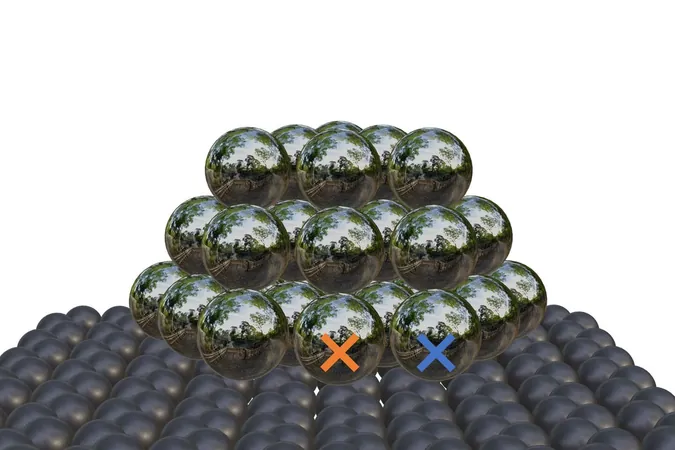
Revolutionary Study Uncovers Why Carbon Supercharges Metal Nanoparticle Catalysts
2024-11-11
Author: Nur
Revolutionary Study Uncovers Why Carbon Supercharges Metal Nanoparticle Catalysts
In a groundbreaking study at TU Wien, researchers have unveiled the secrets behind the impressive performance of metal nanoparticle catalysts, particularly when supported by carbon. Precious metals like silver, platinum, and palladium are pivotal in the chemical industry, performing catalytic reactions critical for the production of a vast array of substances. However, the efficiency of these catalysts is significantly influenced by the material on which they are placed, with carbon-based substrates proving to provide an extraordinary enhancement in catalytic activity.
For decades, the exact reason why carbon supports boost the effectiveness of metal nanoparticles remained elusive. Now, scientists have precisely measured and elucidated the interaction dynamics at play. Their findings indicate that silver atoms on a carbon substrate exhibit catalytic activity that is a staggering 200 times greater than that of pure silver. This research has been documented in the prestigious journal, ACS Catalysis.
From Mystique to Methodology
Prof. Günther Rupprechter from the Institute of Materials Chemistry eloquently commented on the transformation of carbon's role in catalysis from an arcane concept to a scientifically-understood methodology. Collaborating institutions, including the University of Cádiz in Spain, contributed to the project, ensuring a comprehensive exploration of the chemistry involved.
The study revealed that the source of carbon matters significantly. Different carbon types, whether derived from coconut shells, fibers, or specialized wood, can alter catalytic effectiveness. This brings to light previously obscure “recipes” found in patent documents that, while they may seem trivial, are instrumental in determining catalytic efficiency.
Rupprechter acknowledged that in the chemical industry, there is often a tendency to accept operational outcomes without delving into the underlying mechanisms. However, the goal of this research was to understand, at an atomic level, how these dynamics occur.
Precision in Action
In experiments, researchers created highly controlled samples with distinct characteristics: silver nanoparticles affixed to a carbon substrate were compared against a plain silver foil. The results were compelling. Thomas Wicht, the lead author of the study, explained that silver is essential for splitting hydrogen molecules into individual atoms, which can subsequently facilitate critical chemical reactions such as hydrogenation.
A notable innovation allowed the researchers to mix regular hydrogen with deuterium, exchanging heavy hydrogen molecules through silver, effectively revealing the active catalyst dynamics. The spectacular findings confirmed that the presence of carbon increased silver’s catalytic efficiency drastically—a key insight that will have profound implications for industrial applications.
The Interface Effect: A Catalyst's Sweet Spot
Further investigations led by Alexander Genest demonstrated that the catalytic magic lies in the interface where silver nanoparticles and carbon meet. Rather than size or foreign atoms influencing catalytic behavior, the contact zone is where the action occurs. Genest stated that extreme catalytic effects happen precisely at the boundary, highlighting the importance of maximizing this interface for the highest activity.
With these advancements, carbon types can now be easily assessed for their practical applications in various chemical reactions. Rupprechter emphasized that the team’s newly developed experimental method would streamline the evaluation of catalyst effectiveness, paving the way for improved industrial applications while saving both time and costs in quality assurance processes.
This transformative knowledge not only advances our understanding of catalysis at a microscopic level but may also revolutionize how industries utilize precious metal catalysts, opening avenues for innovation in sustainable chemistry and reducing the reliance on expensive materials. As research progresses, the potential for more efficient and eco-friendly chemical processes looks promising. Stay tuned as these developments unfold!




 Brasil (PT)
Brasil (PT)
 Canada (EN)
Canada (EN)
 Chile (ES)
Chile (ES)
 España (ES)
España (ES)
 France (FR)
France (FR)
 Hong Kong (EN)
Hong Kong (EN)
 Italia (IT)
Italia (IT)
 日本 (JA)
日本 (JA)
 Magyarország (HU)
Magyarország (HU)
 Norge (NO)
Norge (NO)
 Polska (PL)
Polska (PL)
 Schweiz (DE)
Schweiz (DE)
 Singapore (EN)
Singapore (EN)
 Sverige (SV)
Sverige (SV)
 Suomi (FI)
Suomi (FI)
 Türkiye (TR)
Türkiye (TR)